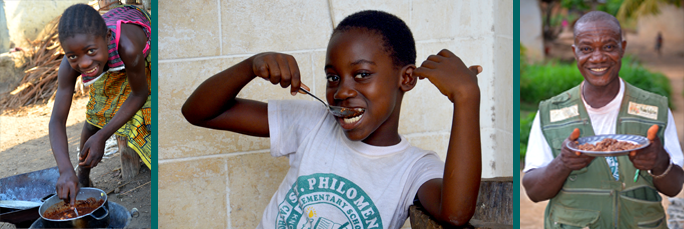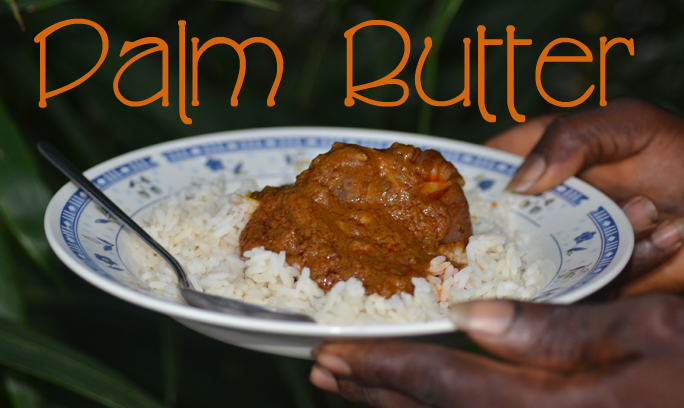
Palm Butter
Palm
Butter was one of the staple dishes in Grand Gedeh County and the
southeast of Liberia. It was kind of a thick stew made with meat
and palm kernels that, of course, was served over a small mountain of
rice. Since the dish wasn’t served throughout Liberia, on this
trip, I wanted to photograph, document, video record, and thoroughly
enjoy my palm butter experience.
My natural connection for this was my friend Joshua, the principal of the Multilateral High School. Since he was on a trip to the United States with four high school students, the next logical step was with his children.
My natural connection for this was my friend Joshua, the principal of the Multilateral High School. Since he was on a trip to the United States with four high school students, the next logical step was with his children.
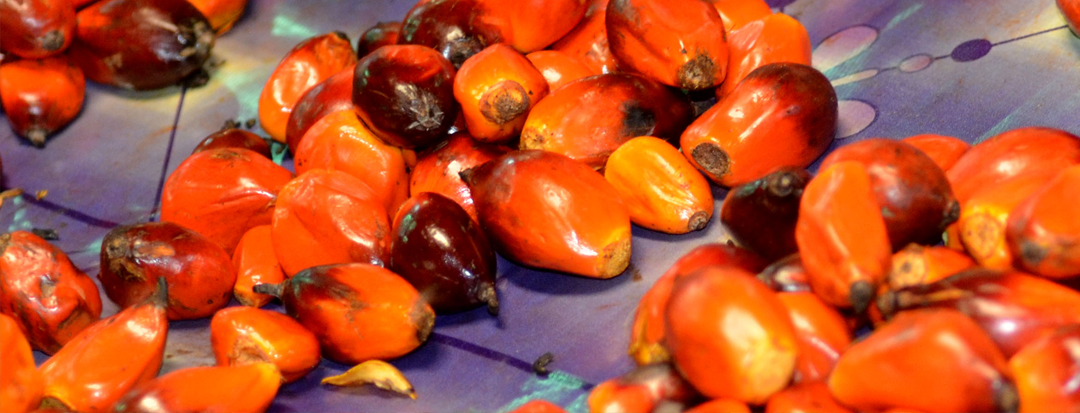
Dorbor
Palm Butter
Zwedru, Liberia
Zwedru, Liberia
Ingredients:
|
1 cutlass (machete)
2 clusters palm nuts 2 cups bitter root 1 handful dried hot peppers |
1 small onion 3 maggi (bouillon) cubes 1 Tbs salt Mountain of rice per person |
It is possible to buy palm oil nuts at the market place, but for my recipe, we went for the fresh stuff. So grab a cutlass (machete) and head for the palm tree in your backyard. It’s much less exhausting to record the experience and safer for all body parts. So, if you have a Liberian friend who grew up using a cutlass for this purpose, perhaps you should grab a camera and leave the hacking for an expert. Chop off some of the lower branches that hide the cluster of palm nuts. You’ll need two clusters for this recipe.
The work with the cutlass isn’t finished yet. Now, it’s necessary to hack away at the clusters to separate the nuts from the stem. Again, I preferred my roll with the camera for this process.
The nuts need to be washed. These days, a few homes in Zwedru have running water. If your house doesn’t, then you go to the well or the hand pump. If that isn’t in your yard, hopefully, there is one close by in your community. This task is very good for young children and gets them involved in the palm butter experience. But, when you carry a bucket of water, Liberians carry it on their heads. It’s not a requirement for you with this recipe.
Start the fire in your coal pot. If you’re on good terms with your neighbors, you can collect a few hot embers of charcoal from their fire and bring them back home. Otherwise, you start from scratch. And, a nice little fire starter that I discovered in the market on this trip was little clusters of scrap rubber about the size of a golf ball. Whatever you do, get the charcoal hot and boil the palm oil nuts for 30 to 45 minutes.
Meanwhile, in your second coal pot, heat up the water to boil two cups of bitter root. I can’t really explain what that is. It sort of looks like little stalks of bamboo. I can tell you that I ate some of it and it deserves its name.
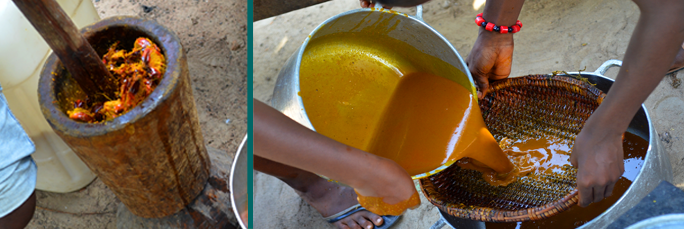
Straining
with a sifter, my new sifter!
When the palm nuts have boiled, take about a third of them and ladle them into a mortar. I didn’t see this done while preparing palm butter, but I like the idea of scouring the pestle with a steel pad and cleaning it up nicely before use. And, with that little bit of preparation, smash those little palm nuts to a pulp.
With all the nuts pulverized, place them in a pot and add a good amount of water. Mix it up with your hands to make it slushy. Squeeze that pulp to help get the oil out of it and continue stirring it all up with your hands. Eventually, you need to pour the slushy mess over a palm strainer (called a sifter) to separate the pulp from the liquid. Keep the seeds but you can trash the pulp.
Nothing is ever wasted in Liberia. Take the nuts over to a place where they can dry in the sun. Eventually, you can crack those little suckers to find a smaller nut inside. It sort of looks like an almond. It’s really hard and not too tasty. I broke some dental work recently biting into some French bread in Europe. It was delicious, but costly. I saw no need to redo that process over something I really didn’t enjoy. While my hosts were distracted with food preparations, I tossed the dozen seeds that a thoughtful young boy collected for me. The meal ended with no emergency dental care required.
A lot of orange palm juice collects in the pot when you poured the slushy mixture over the sifter. For good measure, repeat the process. Then, you can clean and store your sifter for another day while boiling up the palm juice. You need to boil it a long while in order to thicken the brew to the proper consistency. I remember one occasion during the Peace Corps when a volunteer put way too much water in the mix. It just never boiled down to the proper consistency. Our Liberian friends called it “palm water” instead of “palm butter”. You want it thick.
It was at this point in the recipe that my host, Kevin, took me across town to meet his wife and kids. And, you can’t go to an African house without eating. So, while a meal was in the process of preparation for me on one end of town, I sat down for some palm butter with cassava leaves at Kevin’s house. And, I must say, since I love cassava leaves, I liked this dish better. Of course, it could also be because I haven’t told you about the meat yet. Just wait!
There wasn’t much more to be done to the palm butter soup in my absence.
Liberian cooking requires a lot of hot peppers. For this particular dish, there was a handful of dried hot peppers and one small onion tossed into the mortar for smashing before being added to the soup. Every Liberian dish I know uses peppers, onions, maggi cubes (bouillon cubes), and salt to taste. And, don’t forget to add the bitter root!
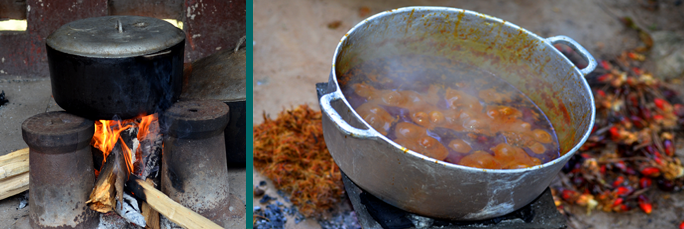
I gave the family money to buy supplies. And, since it was kind of a special occasion with an “honored” guest, they went all out and bought three kinds of meat. There was fish. I only saw fish tails, but I am completely sure there were also fish heads and eyeballs. At least they didn’t stare at me this time. There was chicken. However, the only part of the chicken I actually saw were a whole bunch of chicken feet. You can buy bundles of them at the market. Now, I grew up with chickens. I knew what those feet spent their entire lives standing in. No amount of boiling can make them clean enough for me to want to eat. The third meat was pork. I never actually saw the bits of pork. But, nothing would have surprised me at this point. I fully expected to see a tail or two, a few ears, and a snout.
It didn’t happen.
When dinner was served, I got to serve myself. That was something to be thankful for. There were no awkward moments avoiding of a chicken foot or fish eyeball on my plate. I poured the soup over my rice and got to eat what I wanted. And, what I had was good. I appreciated my hosts who were so willing to let me document their every move. The only way to make it better would be to have their father join us the next time I come to Liberia.
